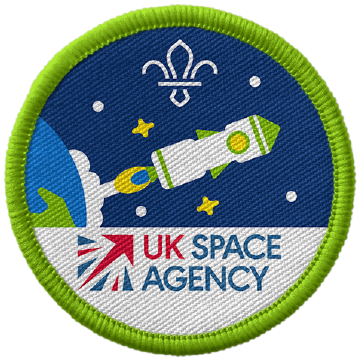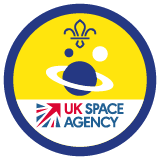
Make some mini moon craters
You’ll need
- Flour or sand
- Cocoa powder
- Cake sprinkles (optional)
- Pebbles / small stones
- Cake tins, baking trays or other containers
- Sieve (optional)
- Pictures of the moon (optional)
Before you begin
- Use the safety checklist to help you plan and risk assess your activity. There's additional guidance to help you carry out your risk assessment, including examples. Don’t forget to make sure all young people and adults involved in the activity know how to take part safely.
- Make sure you’ll have enough adult helpers. You may need some parents and carers to help if you’re short on helpers.
Planning this activity
- Check for allergies and dietary requirements, then adjust the materials as needed. You could use a gluten free flour, such as cornflour or a specific gluten free flour mix, if needed.
- Check if there are any items of food that people can’t touch or if there are items that people might not be comfortable using in the activity. For example, some people may not like the texture or feel or the flour, so they may want to wear gloves or use another material.
- Think about how many young people are attending the session and how many of each item you'll need, such as containers or baking trays. You’ll also need an extra set of equipment for demonstrating.
- This activity works best in small groups, so that everyone can see and get involved. If you don’t have enough cake tins, you could use another type of container.
- You may want to run this activity outside or put something down to help contain the mess.
Setting up this activity
- Add a layer of flour or sand to the bottom of each container. Next, sprinkle a thin layer of cocoa powder on top of the flour or sand. You might find a sieve helpful for this bit. You could also add a handful of sprinkles over the top.
What is the Moon?
- The Moon is a dusty ball of rock and is much smaller than Earth. It’s roughly a quarter of the size of Earth. The moon isn’t a planet.
- The Moon is a lot smaller and closer to Earth than the Sun.
- The Moon always looks bright, but the Moon does not make its own light; it can only reflect light. We see the light reflected off the Moon’s white surface from the Sun. It’s not a source of light, but it acts like a mirror to the Sun’s light.
- The Moon goes round and round (or orbits) the Earth. Its orbit around our planet is shaped like a slightly squashed circle known as an ellipse. This takes 28 days or one lunar month.
- Some other planets have moons too. Saturn has 146 moons that are all different sizes!
Why does the Moon change shape?
- As it orbits the Earth, we see the Moon from different angles each night. It appears to change shape. That’s because as the Moon goes around (or orbits) the Earth, the Sun lights up different parts of its surface – so it’s just our view of the Moon that’s changing, not the Moon itself.
- These shapes are called the phases of the Moon. At times the moon looks like a big circle, which is called a full moon. At other times it seems like the letter C or croissant-shaped and this is called crescent moon.
What's it like on the Moon?
- The Moon has a very rocky surface, with lots of mountains and valleys, just like here on Earth.
- The Moon’s surface doesn’t have any plants or water on it though, but it’s full of holes or craters. Craters are made when large rocks floating through space, known as meteorites, crash into the Moon.
- The moon also has seas, but they’re not made of water. These are dark patches we can see from Earth. The moon’s ‘seas’ are made of hardened lava. Lava is a liquid that comes from volcanoes, but when it cools down, it becomes hard and turns into rock.
- Gravity is a special force that things on Earth. The gravity on the Moon is just one-sixth of the Earth’s, so you would weigh less on the Moon. You could jump higher and carry much heavier things too!
How was the Moon formed?
- Scientists aren’t quite sure how the Moon formed. One popular theory is that a Mars-sized rock, named Theia, crashed into Earth around 4.5 billion years ago. The debris from the collision clumped together to make what is now known as our Moon.
Talk about what the Moon looks like
- Gather everyone together in a circle.
- Ask everyone what they think the Moon looks like. You might want to look at a photo or book that shows the Moon and what it looks like up close.
- Explain that the Moon always looks bright, but the Moon does not make its own light; it can only reflect light. We see the light reflected off the Moon’s white surface from the Sun.
- Ask everyone why they think the Moon looks different each night.
- As the Moon orbits around Earth, it changes shape. Sometimes it can be big and round; this is known as a Full Moon. At other times, the moon looks like the letter C or a croissant shape, and this is called a Crescent Moon. The Moon can also seem to disappear completely each month, and this is called the New Moon. The Moon's still there, but no light from the Sun can reach it to reflect off its surface.
- Ask if anyone knows what the circles on Moon’s surface are called. They’re holes and they’re called craters. You can see them when you look closely at the Moon. The Moon has a very rocky surface, with lots of mountains and valleys, just like here on Earth. The Moon’s surface doesn’t have any plants or water on it though, but it’s full of holes or craters.
- See if any knows, or can guess, how craters are formed. They’re made when large rocks floating through space, known as meteorites, crash into the Moon.
- Tell everyone that they’re going to explore how craters are formed.
Make moon craters
- Show them your container and tell them that the brown cocoa powder is like the Moon’s surface.
- Pick up a pebble and explain that this is like the space rocks, known as meteoroids. Ask everyone what they think will happen when you drop the rock.
- Drop the pebble into the sand and talk about what happened. Does the coca powder still look the same? What’s moved and changed? What do they think happens when big space rocks hit into the Moon’s surface? Remember, craters are formed when objects, just like meteoroids, crash into the Moon’s surface.
- Divide everyone into small groups and give them a container each and a few pebbles.
- Everyone should take turns to have a go at creating Moon craters. Encourage them to chat to each other about what they can see.
- You could use rulers to measure the different sizes of the circles or craters formed by your pebbles, then get everyone to make predictions of how big the crater made by each pebble will be. You could also see if pebbles dropped closer or further away from the flour/sand will make a smaller or bigger crater.
Reflection
This activity was all about learning about the Moon’s craters. Can anyone remember how a crater is formed and what causes them?
We had to drop pebbles to make our own mini Moon craters. What was it like dropping the pebbles? Which pebbles made the bigger craters and which made smaller ones? Did anything else impact how big the crater was going to be?
Neil Armstrong was the first person to walk on the moon. What do you think it’s like to walk on the Moon? Where would you travel to in space? What would you take with you if you travelled into space or went to the moon? Is there anything else you’d like to know about the Moon? Is there anything else you’d like to know about space?
Safety
All activities must be safely managed. You must complete a thorough risk assessment and take appropriate steps to reduce risk. Use the safety checklist to help you plan and risk assess your activity. Always get approval for the activity, and have suitable supervision and an InTouch process.
- Food
Remember to check for allergies, eating problems, fasting or dietary requirements and adjust the recipe as needed. Make sure you’ve suitable areas for storing and preparing food and avoid cross contamination of different foods. Take a look at our guidance on food safety and hygiene.
- Remember to check for allergies and dietary requirements, and adjust the materials as needed. Check if there are any items of food that people can’t touch or if there are items that people might not be comfortable using in the activity.
- If someone doesn’t want to drop the pebbles, they could place the pebbles down, they could choose which pebbles to use or they could predict how big the crater is going to be. They could also have a partner or adult to help.
All Scout activities should be inclusive and accessible.
Why not see where else everyone can spot the Moon? Can they see it in the sky, in stories, or pictures? You could talk about what they’ve found out next time.
Learn more about the phases of the Moon by making some biscuit moons.
Explore what else everyone knows about the Moon and what they’d like to find out next. As a group, decide how you'll discover more.

